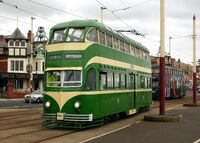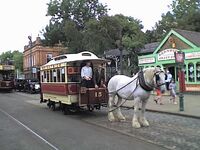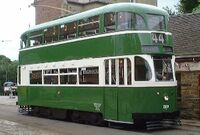March 2008[]
The Blackpool tramway runs from Blackpool to Fleetwood on the Fylde Coast in Lancashire, England and is the only surviving first-generation tramway in the United Kingdom (UK). The tramway dates back to 1885 and is one of the oldest electric tramways in the world. It is run by Blackpool Transport as part of the Metro Coastlines, owned by Blackpool Borough Council. The tramway runs for 11 miles and carries 6,500,000 passngers each year.
The first part of the tramway opened on 29 September 1885, a conduit line running from Cocker Street to Dean Street on Blackpool Promenade. It was one of the first practical electric tramways in the world, just six years after Werner von Siemens first demonstrated electric traction. The inauguration was presided over by Holroyd Smith, the inventor of the system, and Alderman Harwood, the Mayor of Manchester.
April 2008[]
The first tramway line, which was horse-drawn, started in 1873 with the opening of a line between Lady's Bridge and Attercliffe. This line was subsequently extended to Brightside and Tinsley. Routes were built to Heeley, where a tram depot was built, Nether Edge and Hillsborough.
In 1899, the first electric tram ran between Nether Edge and Tinsley. By 1902 all the routes were electrified. By 1910, the Sheffield Tramway network covered 39 miles, in 1951 the network was extended to 48 miles.
The last trams ran between Leopold Street and Beauchief on 8 October 1960—three Sheffield trams were subsequently preserved at the National Tramway Museum in Crich.
May 2008[]
Tramlink (initially known as Croydon Tramlink) is a tramway system serving the south London area of England, United Kingdom. The service is currently operated by FirstGroup on behalf of Transport for London (TfL) but it has been agreed that TfL will purchase the system and take control of it later in 2008. Tramlink meets National Rail lines at a number of stations, but because it runs in an area relatively under-served by the London Underground (one of the reasons for its creation), its only interchange with the Underground is at Wimbledon. The system, centred on Croydon, began operation in May 2000.
Tramlink consists of a mixture of street track shared with other vehicles, dedicated track within the street, and off-street track. The off-street track includes new rights-of-way, former railway lines, and one section that shares the right-of-way (though not track) with a third-rail electrified Network Rail line.
June 2008[]
Glasgow Corporation Tramways were formerly one of the largest urban tramway systems in Europe. Over 1000 municipally-owned trams served the city of Glasgow, Scotland. The system closed in 1962.
The Glasgow Street Tramways Act was passed by Act of Parliament in 1870. The act provided legislation that allowed Glasgow Town Council the right to decide whether or not they were willing to have tramways within Glasgow.[1] In 1872, the Town Council laid a 2½-mile route from St George's Cross to Eglinton Toll (via New City Road, Cambridge Street, Sauchiehall Street, Renfield Street and the Jamaica Bridge).
The Tramways Act prohibited the Town Council from directly operating a tram service over the lines. The act further stipulated that a private company be given the operating lease of the tram-lines for a period of 22 years.[2] The St George's Cross to Eglinton Toll tram line was opened on 19 August 1872 with a horse-drawn service by the Glasgow Tramway and Omnibus Company[3]. The Glasgow Tramway and Omnibus Company operated the tram-line and subsequent extensions to the system until 30 June 1894.
In declining to renew the Glasgow Tramway and Omnibus Company operating lease, Glasgow Town Council formed the Glasgow Corporation Tramways and commenced their own municipal tram service on 1 July 1894.
July 2008[]
Main Page/Selected Article/Archive/2008/July
August 2008[]
Main Page/Selected Article/Archive/2008/August
September 2008[]
Main Page/Selected Article/Archive/2008/September
October 2008[]
The Liverpool Tramways Company was authorised by Act of Parliament in 1868. It opened in November 1869 and its successors ran trams until 14 September 1957. The system ran from the Pier Head throughout the city.
Liverpool's last tram (No 293) ran from Liverpool's Pier Head to Bowring Park on September 14, 1957.
The car was bought by the National Trolley Museum of Kennebunkport, Maine, U.S.A and shipped via Boston, Massachusetts in 1958. The height of the car and its low loader were too high to go under the bridges of Boston to get onto the highway to Kennebunkport, so special arrangements were made to transport it across Boston Airport and out of the back entrance on to the highway, thus avoiding the low bridges.
Car No 293 is, as of 2006, at the back of a shed at the Museum, and is in poor condition.
OTHER SURVIVING LIVERPOOL TRAMS
Horse car 43 is a static exhibit at the Wirral Transport Museum in Birkenhead.
Car No 245 is now under restoration, after many years in store, by members of the Merseyside Tramway Preservation Society at the Wirral Transport Museum in Birkenhead.
Car 762 is operational at the Wirral Transport Museum.
Car 869 (also known as a "Green Goddess") is operational at the National Tramway Museum at Crich in Derbyshire.
November 2008[]
Main Page/Selected Article/Archive/2008/November
December 2008[]
Main Page/Selected Article/Archive/2008/December
- ↑ Ronald W. Brash, Glasgow in the Tramway Ages - Page 27, Longman, 1971, ISBN 0582204887
- ↑ Ronald W. Brash, Glasgow in the Tramway Ages - Page 28, Longman, 1971, ISBN 0582204887
- ↑ Charles Frederick Klapper, The Golden Age of Buses - Page 22, Routledge, 1984, ISBN 0710202326





